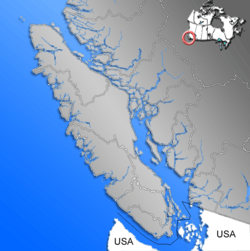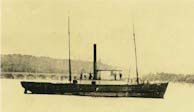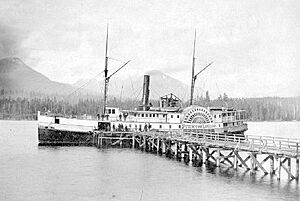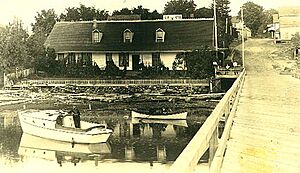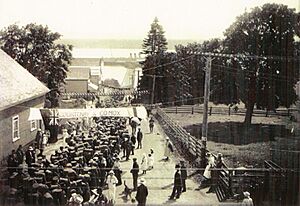Comox, British Columbia facts for kids
Quick facts for kids
Comox
|
|||
|---|---|---|---|
|
Town
|
|||
| Town of Comox | |||

Aerial view of Comox in 2011
|
|||
|
|||
| Country | Canada | ||
| Province | British Columbia | ||
| Region | Mid-Island | ||
| Regional district | Comox Valley | ||
| Incorporated | 1953 | ||
| Area
(2021)
|
|||
| • Total | 16.87 km2 (6.51 sq mi) | ||
| Elevation | 84 m (276 ft) | ||
| Population
(2021)
|
|||
| • Total | 14,806 | ||
| • Density | 877.7/km2 (2,273/sq mi) | ||
| Time zone | UTC−08:00 (PST) | ||
| Forward sortation area |
V9M
|
||
| Area code(s) | 250, 778, 236 | ||
Comox (pronounced KOH-moks) is a town located on the eastern coast of Vancouver Island in British Columbia, Canada. It sits on the southern part of the Comox Peninsula, right by the Strait of Georgia. Thousands of years ago, this area was perfect for the First Nations people. They loved the warm, dry summers, mild winters, good soil, and lots of sea life. They called the area kw'umuxws, which means "plentiful" in the Kwakʼwala language.
In the mid-1800s, Comox became open for new settlers. Soon, farmers, loggers, and fishers moved in. For over 50 years, the town was mostly reached by ship. Then, during World War I, roads and a railway were built. Later, in World War II, an air force base was built nearby, which brought more growth. Today, Comox is a popular spot for tourists who enjoy fishing, seeing local wildlife, playing golf all year, and visiting nearby ski areas like Mount Washington Alpine Resort.
The town is also home to CFB Comox, a Royal Canadian Air Force base that serves as both a military and commercial airport. It also has HMCS Quadra, a training facility for Royal Canadian Sea Cadets. Many retired people have moved to Comox because of its mild climate, which has made the town grow quickly.
Comox is part of the Comox Valley, which includes other communities like Courtenay and Cumberland. The amazing Comox Glacier can be seen from many parts of the town and is a famous landmark. Comox is also close to Denman Island in the Strait of Georgia.
Contents
Exploring Comox's Past
Ancient History of Comox
Scientists have found proof that people were fishing in Comox Bay at least 4,000 years ago. The mild weather, good soil, and lots of sea life made the area "plentiful." This is why the Kʼómoks people, who lived here, called it kw'umuxws, which later became "Comox."
When Europeans first arrived, the Pentlatch Nation lived along Comox Bay. They spoke a dialect of the Coast Salish language. Another group, the Kʼómoks, lived further north near Campbell River.
The Pentlatch people used clever fishing traps called weirs. These were nets tied to wooden stakes on muddy flats. At high tide, the nets would be covered, trapping fish. At low tide, the fish could be easily collected. You can still see thousands of these wooden stakes at low tide today! Some stakes are over 1,200 years old. These traps could have fed thousands of people. The Pentlatch also gathered lots of shellfish. Over many centuries, their discarded shells formed a huge pile along the shore, now called the Great Comox Midden.
By the 1800s, the Kʼómoks people had moved south to Comox. They joined with the Pentlatch to protect themselves from another powerful group, the Laich-kwil-tach. In 1862, a terrible smallpox sickness spread across Vancouver Island, killing many First Nations people. By 1876, only a small number of Kʼómoks and Pentlatch people remained in the Comox Valley.
First European Visitors
In 1579, Francis Drake might have visited Comox during his trip around the world. He called the area "New Albion." However, his detailed notes were lost later.
In 1791, Spanish explorers made a rough map of the Strait of Georgia and might have visited Comox. The next year, George Vancouver arrived. He was sent by the British government to map the northwest coast of North America. Vancouver explored the area around Comox and mapped its shoreline.
Comox Becomes a Town
By the mid-1800s, European settlements were growing in Vancouver and southern Vancouver Island. In 1837, the Hudson's Bay Company looked for new trading post locations and set up one in the area, calling it "Komoux."
Constance|1846|6, a British ship, often visited the area. Its captain, Courtenay, gave his name to the river flowing through the valley. In 1857, Captain George Richards officially named it the Courtenay River.
In 1853, Sir James Douglas, the governor of Vancouver Island, saw that the Comox area was great for farming. In 1861, he offered land for $1 an acre and free travel to encourage settlers.
The first official settlers arrived in 1862 on Grappler|1856|6. James Robb and his son saw that the old Kʼómoks fishing village area was protected from winds. They bought land there, planning to clear it and sell lots for a new town.
As Robb expected, supplies for settlers had to be brought to his land, which became known as "The Landing" or "Port Augusta." Robb also started a successful farm.
Getting supplies and mail was hard because ships came rarely, and a road from Nanaimo was too expensive to build. A rough path was made, but it was often blocked.
In 1864, valuable coal was found nearby, but mining didn't start for another 20 years.
By 1876, the Kʼómoks and Pentlatch people were moved to two reserves: Comox Indian Reserve No. 1 and Pentledge Indian Reserve No. 2. A third area, Graveyard Indian Reserve #3 on the Goose Spit, was set aside for their historic burial grounds.
In 1874, the government built a wharf (a pier for ships) at The Landing. This made it easier for large ships to unload goods. An Italian immigrant, Joseph Rodello, bought land next to the wharf and quickly built a store.
By 1871, about 100 people lived in The Landing area. In 1876, the Royal Navy built a naval base on the Goose Spit. The next year, Joseph Rodello built the Elk Hotel near his store. The first school was built in 1877.
In 1878, the Hudson's Bay Company post closed because it was too far from the wharf. Other businesses, like the Lorne Hotel, opened. In 1880, Rodello's store burned down but was rebuilt. A Catholic church was built in 1886.
In 1888, coal mines opened in nearby Cumberland. The mine owners wanted to use Comox as a shipping point, but James Robb asked for too much money for his land. So, they built a wharf at Union Bay instead.
James Robb died in 1889, having sold only a few lots. Joseph Rodello also died around the same time. In 1891, the Comox District Free Press newspaper started.
In 1893, the government changed the name of the village, valley, and bay from Augusta to Comox. Two years later, a telegraph office opened, connecting Comox to the outside world instantly.
Comox in the 1900s
In the early 1900s, new technology arrived. Telephone service began in 1910. The Comox Logging and Railway Company started logging the huge Douglas fir forests. This company became the biggest logging business on the British Columbia Coast. They used steam-powered machines and trains to move billions of feet of timber.
Also in 1910, a road from Nanaimo was finally built, connecting Comox to southern Vancouver Island. Electricity arrived in nearby Courtenay in 1913 and in Comox in 1920. In 1914, the E&N Railway reached Courtenay, making mail service much faster. A hospital, St. Joseph's Hospital, opened in 1914.
During World War I, many local men joined the Canadian Expeditionary Force. The local 102nd Battalion was formed in 1915, and their training camp was at the Goose Spit. They trained in harsh winter conditions, which prepared them for the war. On June 10, 1916, they left Comox for Europe. They fought in many major battles and suffered heavy losses.
After the war, the Lorne and Elk Hotels reopened. In 1921, William Robb died, and his land was bought by a group of local businessmen. Some land was used for a new golf course.
A man named Sidney "Dusty" d'Esterre helped bring tourists to Comox. He advertised the great fishing for "Tyee" (large chinook salmon), golf, and other activities. Comox became a popular holiday spot for wealthy tourists.
In 1922, naturalist Hamilton Mack Laing moved to Comox. He became an important voice for protecting nature, writing many articles about birds and wildlife. He bought land along Comox Bay and built a house.
In 1924, the army left the Goose Spit, and the Royal Navy took it over again. A new Comox school was built in 1927. The Comox Golf Course opened in 1928.
In 1929, R.J. Filberg, a logging company manager, and his wife built a beautiful summer lodge on the shores of Comox Bay. They loved it so much they made it their full-time home in 1935. This lodge and its gardens are now a public park called the Filberg Heritage Lodge and Park.
In 1931, a local army unit, "C" Company of the Canadian Scottish Regiment, was formed. In World War II, they were sent to England and later took part in the D-Day invasion on Juno Beach.
In 1940, the Royal Navy built a training facility on the Goose Spit called HMCS Naden (III).
In 1941, Highway 1 (now Highway 19) was built, connecting Comox to Nanaimo and Campbell River.
In 1942, after the attack on Pearl Harbor, the Royal Air Force (RAF) chose Comox for an air base because of its good flying weather. RAF Station Comox was quickly built. The next year, the Royal Canadian Air Force (RCAF) took over, using the base for patrols and training.
After World War II, the base was closed for a while. But in 1952, due to the Cold War, it was reopened and has been operating ever since as CFB Comox (YQQ). The airfield was made longer, and a civilian airport terminal was added in 1956. Today, the Comox Valley Airport is used by both the military and commercial airlines.
In 1954, HMCS Naden (III) became a cadet training base and was renamed HMCS Quadra in 1956.
By 1967, the town's population grew to 2,500 because of military personnel moving in. In the 1970s, the government set aside most of the valley for farming, which slowed down building in the town. In 1972, the old Elk Hotel burned down. The old pier was removed, and a marina for boats was built.
In 1977, Bob Filberg died and left his lodge to a foundation. Local residents saved it from being torn down, and it became the Filberg Heritage Lodge and Park.
In 1979, the first ski runs were built on Mount Washington Alpine Resort, attracting more tourists. However, in 1982, the local economy faced a challenge when a military squadron moved away, causing many families to leave Comox.
In 1983, naturalist Hamilton Mack Laing died. He left his house and land along Comox Bay to the town, asking that it remain natural. This became the Mack Laing Nature Park.
In 1991, another military squadron was assigned to CFB Comox, boosting the local economy. More retirees also started moving to Comox. Property values began to rise as land was developed for new residents.
In 1987, the Comox Valley Record newspaper started. In 1994, the Comox District Free Press closed down. Many of its former employees started a new paper, the Comox Valley Echo, the next year.
In 1994, Queen Elizabeth II visited Comox briefly.
Comox Today: The 21st Century
At the start of the 2000s, Comox Valley still had a lot of farmland, but jobs were shifting away from fishing and logging. The biggest employers became CFB 19 Wing Comox, the local school board, Mount Washington Alpine Resort, and St. Joseph Hospital.
Daily commercial flights helped tourism and business grow. Comox's population, which had been steady for a while, increased by 6.5% between 2001 and 2006. Many new residents were retirees, making the town's average age higher.
In 2011, the 133-year-old Lorne Hotel, a very old hotel in British Columbia, was destroyed by fire.
Comox Population Facts
In 2021, Comox had a population of 14,806 people. This was a small increase from 14,028 people in 2016. The town covers an area of about 16.87 square kilometers.
The average age of people in Comox in 2021 was 52.5 years old. The average household income after taxes in 2020 was $74,500.
People from Different Backgrounds
Comox is home to people from many different backgrounds. Here's a look at the main groups:
| Panethnic group |
2021 | 2016 | 2011 | 2006 | 2001 | |||||||||
|---|---|---|---|---|---|---|---|---|---|---|---|---|---|---|
| Pop. | % | Pop. | % | Pop. | % | Pop. | % | Pop. | % | |||||
| European | 12,645 | 88.24% | 12,410 | 90.55% | 12,520 | 94.24% | 11,275 | 93.88% | 10,470 | 95.05% | ||||
| Indigenous | 980 | 6.84% | 780 | 5.69% | 450 | 3.39% | 360 | 3% | 360 | 3.27% | ||||
| East Asian | 210 | 1.47% | 220 | 1.61% | 100 | 0.75% | 75 | 0.62% | 80 | 0.73% | ||||
| Southeast Asian | 160 | 1.12% | 75 | 0.55% | 55 | 0.41% | 35 | 0.29% | 40 | 0.36% | ||||
| South Asian | 100 | 0.7% | 60 | 0.44% | 30 | 0.23% | 10 | 0.08% | 20 | 0.18% | ||||
| African | 100 | 0.7% | 60 | 0.44% | 100 | 0.75% | 215 | 1.79% | 30 | 0.27% | ||||
| Latin American | 30 | 0.21% | 50 | 0.36% | 25 | 0.19% | 30 | 0.25% | 10 | 0.09% | ||||
| Middle Eastern | 0 | 0% | 20 | 0.15% | 0 | 0% | 20 | 0.17% | 10 | 0.09% | ||||
| Other / Multiracial | 105 | 0.73% | 35 | 0.26% | 0 | 0% | 10 | 0.08% | 10 | 0.09% | ||||
| Total responses | 14,330 | 96.79% | 13,705 | 97.7% | 13,285 | 97.49% | 12,010 | 98.96% | 11,015 | 96.7% | ||||
| Total population | 14,806 | 100% | 14,028 | 100% | 13,627 | 100% | 12,136 | 100% | 11,391 | 100% | ||||
| Note: Totals greater than 100% due to multiple origin responses | ||||||||||||||
Languages Spoken in Comox
In 2016, most people in Comox (12,440) spoke English as their first language. French was the second most common, spoken by 480 people.
Religions in Comox
Based on the 2021 census, here are the religious groups in Comox:
- No religion: 8,415 people (58.7%)
- Christianity: 5,540 people (38.7%)
- Buddhism: 70 people (0.5%)
- Judaism: 40 people (0.3%)
- Sikhism: 35 people (0.2%)
- Hinduism: 25 people (0.2%)
- Islam: 10 people (0.1%)
- Other religions: 205 people (1.4%)
Comox Weather and Climate
Comox has a warm-summer mediterranean climate. This means it has dry, sunny summers and mild, wet winters. Because it's on a small peninsula surrounded by water, Comox has pleasant weather all year.
Summer temperatures usually average around 22°C and rarely reach 30°C. Winter temperatures rarely drop below freezing. Comox gets about 1,179 mm of rain each year, but most of it falls between October and March. It usually rains, not snows.
The hottest temperature ever recorded in Comox was 38.0°C on June 27, 2021.
| Climate data for Comox (Comox Airport) WMO ID: 71893; coordinates 49°43′N 124°54′W / 49.717°N 124.900°W; elevation: 25.6 m (84 ft); 1991–2020 normals, extremes 1991–present |
|||||||||||||
|---|---|---|---|---|---|---|---|---|---|---|---|---|---|
| Month | Jan | Feb | Mar | Apr | May | Jun | Jul | Aug | Sep | Oct | Nov | Dec | Year |
| Record high humidex | 16.2 | 15.8 | 19.6 | 26.2 | 31.6 | 37.3 | 40.4 | 40.3 | 33.7 | 26.0 | 20.9 | 17.7 | 40.4 |
| Record high °C (°F) | 16.7 (62.1) |
16.3 (61.3) |
19.6 (67.3) |
26.8 (80.2) |
31.7 (89.1) |
38 (100) |
35.2 (95.4) |
33.6 (92.5) |
31.7 (89.1) |
22.9 (73.2) |
17.8 (64.0) |
17.4 (63.3) |
35.2 (95.4) |
| Mean daily maximum °C (°F) | 6.3 (43.3) |
7.2 (45.0) |
9.5 (49.1) |
12.9 (55.2) |
17.2 (63.0) |
19.9 (67.8) |
23.1 (73.6) |
23.0 (73.4) |
19.1 (66.4) |
12.9 (55.2) |
8.7 (47.7) |
6.2 (43.2) |
13.8 (56.8) |
| Daily mean °C (°F) | 3.9 (39.0) |
4.2 (39.6) |
6.1 (43.0) |
9.0 (48.2) |
12.9 (55.2) |
15.7 (60.3) |
18.5 (65.3) |
18.3 (64.9) |
14.8 (58.6) |
9.6 (49.3) |
5.9 (42.6) |
3.7 (38.7) |
10.2 (50.4) |
| Mean daily minimum °C (°F) | 1.5 (34.7) |
1.2 (34.2) |
2.6 (36.7) |
5.0 (41.0) |
8.6 (47.5) |
11.5 (52.7) |
13.7 (56.7) |
13.5 (56.3) |
10.5 (50.9) |
6.3 (43.3) |
3.1 (37.6) |
1.3 (34.3) |
6.6 (43.9) |
| Record low °C (°F) | −21.1 (−6.0) |
−16.1 (3.0) |
−13.9 (7.0) |
−4.4 (24.1) |
−2.8 (27.0) |
0.5 (32.9) |
5.0 (41.0) |
3.3 (37.9) |
−1.7 (28.9) |
−4.8 (23.4) |
−13.3 (8.1) |
−15.0 (5.0) |
−21.1 (−6.0) |
| Record low wind chill | −18.6 | −21.6 | −16.1 | −5.9 | −2.0 | 0.0 | 0.0 | 0.0 | −2.7 | −9.8 | −20.3 | −25.0 | −25.0 |
| Average precipitation mm (inches) | 177.4 (6.98) |
111.6 (4.39) |
107.5 (4.23) |
64.1 (2.52) |
40.3 (1.59) |
41.8 (1.65) |
23.8 (0.94) |
31.2 (1.23) |
46.7 (1.84) |
125.4 (4.94) |
188.8 (7.43) |
193.6 (7.62) |
1,152.2 (45.36) |
| Average rainfall mm (inches) | 165.1 (6.50) |
102.6 (4.04) |
98.4 (3.87) |
64.1 (2.52) |
40.3 (1.59) |
41.8 (1.65) |
23.8 (0.94) |
31.2 (1.23) |
46.7 (1.84) |
125.3 (4.93) |
183.5 (7.22) |
177.3 (6.98) |
1,099.9 (43.30) |
| Average snowfall cm (inches) | 12.4 (4.9) |
9.0 (3.5) |
6.8 (2.7) |
0.0 (0.0) |
0.0 (0.0) |
0.0 (0.0) |
0.0 (0.0) |
0.0 (0.0) |
0.0 (0.0) |
0.1 (0.0) |
5.5 (2.2) |
16.9 (6.7) |
50.8 (20.0) |
| Average precipitation days (≥ 0.2 mm) | 19.9 | 16.2 | 16.9 | 13.9 | 11.6 | 11.2 | 7.1 | 7.0 | 9.8 | 17.1 | 19.7 | 21.2 | 171.6 |
| Average rainy days (≥ 0.2 mm) | 18.9 | 15.0 | 16.3 | 13.9 | 11.6 | 11.2 | 7.1 | 7.0 | 9.8 | 17.0 | 19.4 | 20.2 | 167.5 |
| Average snowy days (≥ 0.2 cm) | 2.4 | 2.3 | 1.6 | 0.07 | 0.0 | 0.0 | 0.0 | 0.0 | 0.0 | 0.10 | 0.83 | 2.7 | 10.0 |
| Average relative humidity (%) (at 1500 LST) | 83.8 | 76.5 | 70.4 | 63.8 | 61.5 | 60.2 | 57.3 | 57.6 | 62.8 | 75.8 | 81.3 | 83.4 | 69.5 |
| Mean monthly sunshine hours | 57.8 | 87.6 | 125.2 | 182.5 | 230.7 | 230.1 | 300.0 | 268.8 | 226.9 | 116.3 | 57.6 | 41.4 | 1,925.8 |
| Percent possible sunshine | 21.6 | 30.7 | 34.0 | 44.3 | 48.5 | 47.4 | 61.1 | 60.1 | 59.8 | 34.7 | 21.0 | 16.3 | 40.0 |
| Source: Environment and Climate Change Canada (sun 1981–2010) | |||||||||||||
Fun Things to Do in Comox
The Filberg Festival is a popular arts and crafts fair held every summer at Filberg Park. On the same weekend, Comox also hosts "Nautical Days" at Comox Marina Park. This event features an arts and crafts festival, a parade, a classic car show, a boat-building competition, and live music.
Comox has two interesting museums. The Comox Museum and Archives shows the history of the town. The Comox Air Force Museum tells the story of 19 Wing and important achievements in military aviation.
The Comox North-East Woods is a protected area with many walking and biking trails. It also includes the Lazo Marsh-North East Comox Wildlife Management Area, which is great for seeing wildlife.
Schools in Comox
The School District 71 Comox Valley runs the public schools in Comox.
Elementary schools:
- Airport Elementary
- Aspen Park Elementary
- Brooklyn Elementary
- École Au Coeur de l'île (a French-speaking school)
- École Robb Road Elementary (offers French immersion)
Secondary schools:
- Highland Secondary School
(Some Comox students also go to Mark R. Isfeld Senior Secondary School or Georges P. Vanier Secondary School in Courtenay)
Comox also has a private Christian school called Phil and Jennie Gaglardi Academy (for K–12).
The Conseil scolaire francophone de la Colombie-Britannique operates one French-speaking primary and secondary school, École Au-coeur-de-l'île.
Colleges in Comox
- North Island College
- Excel Career College
- North Island Distance Education Society
- Sprott Shaw College
Comox in the Media
Newspapers
- Comox Valley Record
- Island Word
- CFB Comox Totem Times
Radio Stations
- CKLR-FM – 97.3 MHz
- CFCP-FM – 98.9 MHz
Television
- Shaw TV – Cable 4
Famous People from Comox
These people either grew up in Comox or lived there for a long time:
- Pamela Anderson, actress, known for Baywatch
- Carle Brenneman, Olympic snowboarder
- Brett Cairns, Air Force Major General
- Byron Dafoe, National Hockey League (NHL) hockey player
- Taylor Green, infielder for the Milwaukee Brewers
- Andrew Hallam, Best selling finance author
- Thomas Herschmiller, rower, won a silver medal at the 2004 Athens Olympics
- Adin Hill, NHL goaltender
- John Stephen Hill, playwright
- Brett McLean, NHL hockey player
- Gig Morton, actor, known for Mr. Young
- Alice Munro, Nobel Prize-winning author
- Cam Neely, NHL hockey player
- Matt O'Donnell, offensive lineman for the Edmonton Elks
- Jonathon Power, squash player
- Cassie Sharpe, Olympic skier
- Roy Sharplin, Olympic whitewater slalom canoer
- Emily St. John Mandel, novelist and essayist
- Darcy Turenne, freeride cyclist
- Ty Wishart, NHL hockey player
Special Honors for Comox
The following people and military units have received the Freedom of the Town of Comox, which is a special honor.
Individuals Honored
- Wing commander James Francis "Stocky" Edwards: June 2007.
- John Marinus: August 16, 2017.
- Russ Arnott: October 5, 2022.
Military Units Honored
- HMCS Quadra
- 19 Wing Comox
Images for kids




